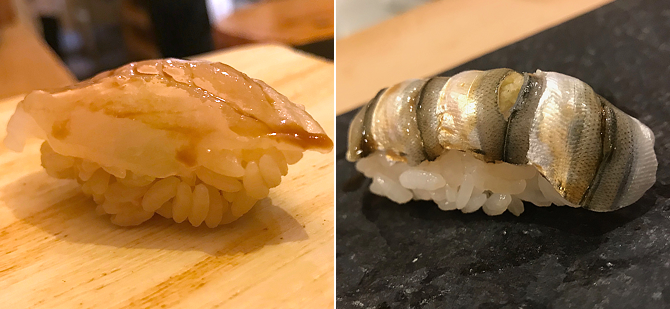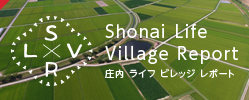Ishinomaki Rice Paddy Support Business Aug.2018.
Adjusting the rice planting season
through deduction
JP
EN
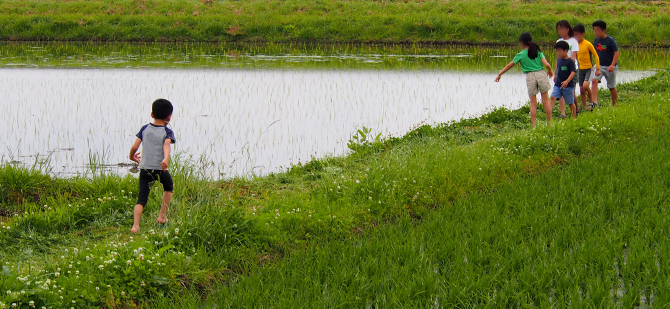
Looking at the map of the Tohoku region, flat land extends straight northwards from Sendai, so as to vertically split the northern part of Honshu, which is otherwise virtually mountainous. The Kitakami River flows southwards through this flat land, like a backbone. In the Heian period, the Kitakami was a major river that functioned as the hub for the Ezo soldiers, who were led and trained by a legendary hero and fought bravely in a defensive war against the military of the imperial court. Along this river from Miyagi Prefecture to Aomori Prefecture, we can find villages where generals were stationed, and mountains where many forts were built in the ancient battle, many with names referencing that history. Although they are significant remnants of the history of Tohoku, they hardly appear in textbooks. In the expression, “history is written by winners”, it represents how the history of the defeated is likely distorted and can even be eliminated. So many histories having been distorted and eliminated in this land! During my trip to Ishinomaki, I had a chance to hear such stories from growers.
By the way, I believe that the folklorist and bureaucrat, Kunio Yanagita, had once written that the faith among common people was influenced and led by the central government as to the god that should be worshipped, with even some shrines being excluded that were old to the area.
And now Sasanishiki rice is on my mind.
Sasanishiki once shared popularity with Koshihikari rice. But it has become so rare, almost like a passing dream as it is difficult to cultivate and has far fewer farmers that produce it.
As well, farmers who have adopted organic cultivation, who avoid the use of pesticides and fertilizers, are rare.
So, I would say, the farmer who produces Sasanishiki by organic cultivation is really rare. Such a farm has limitless devotion in order to pass Sasaishiki on to the future. Even if it’s a little step, it is a significant effort being carved in history.
About a year ago, we at Office Mulberry were consulted by Mr. Kimura, the director of Dendenmushi, a natural rice farming firm in Ishinomaki, and decided to support their project so we could contribute to the introduction of a facility which could be shared by the community. It wasn’t difficult to make the decision to support their project, as I had become acquainted with Dendenmushi when I participated in a reconstruction support project after the Great East Japan Earthquake and was already familiar with their efforts and approach to rice cultivation.
At Dendenmushi, they use neither pesticides nor fertilizers, even at the seedling stage. Thus, at the time of planting, their seedlings look younger than seedlings produced by other farmers. They plant their young seedlings in paddy fields at a time slightly later than ordinary farmers. This is a contrivance in order to time the emergence of the ear of the rice so that it appears during optimum temperatures.
However, because of their delayed planting, temperatures can be high and it causes the occurrence of algae, called “noro,” which then grows in the paddy fields. It’s likely to be known as spirogyra. This noro floats and is blown along the furrows, and it then covers young seedlings and hinders their growth. The farmer must remove it from the paddy fields and dispose of it on the furrow. It may be low-tech, but it’s the way to remove scum in these paddy fields.
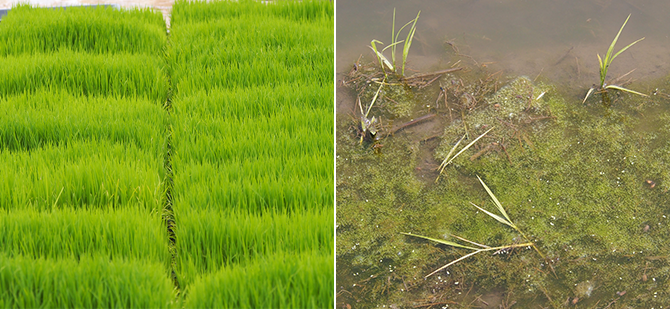
Dendenmushi anticipates the heading stage (or earing phase) in their paddy fields to occur around mid-August. Compared to other farmers, who have their heading stage around July 20th, it is nearly a month later. They have their ear emergence at a time of a slightly different range of temperatures. According to the director, Mr. Kimura, it prevents the occurrence of defective rice, called “nyuhakuryu,” which has less starch accumulation.
At Dendenmushi, it is said that the parents of Mr. Kimura had begun cultivating rice with no pesticides or fertilizers since 1987, and Mr. Kimura took over their business in 2005.
Depending on the rice field, their organic farming has continued from anywhere between 20 years to 30 years. Even now, crayfish, frogs, and tadpoles still thrive in their paddy fields.
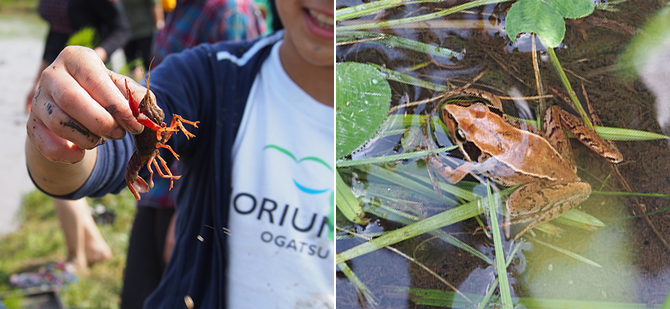
It’s now summer, and weeds grow as well as the rice itself does. The struggle between Dendenmushi and weeds has already begun. On June 9th, a rice planting event, in which the children of the city were invited to participate in, was held at their paddy fields. This is a part of their continued effort to ensure that the charm of paddy fields is inherited by following generations. The young seedlings that were not smothered by the noro algae had firmly taken root and had begun to grow, when I visited on July 17th. Looking upon the paddy fields, I could see the weeds on the furrow were neatly mown. Dendenmushi is expecting their rice harvest to be in late October, so their efforts in farming will continue until then.
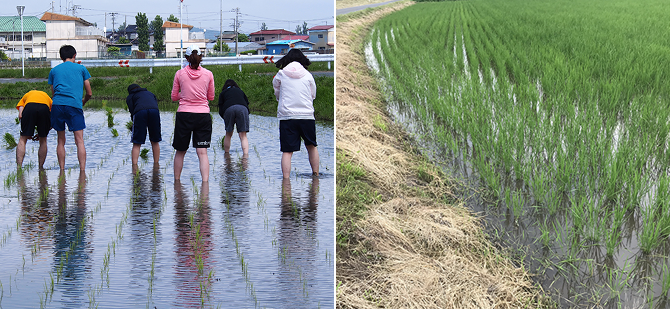
By the way, being referred to by Dendenmushi, I visited a couple of sushi restaurants which use their Sasanishiki rice in Kanagawa Prefecture and Osaka. As I am not particular about food, cooking commentary isn’t my forte, but both restaurants served me sushi having a splendid taste and aftertaste, which made me want to go back to them right after leaving! The taste made me feel like wanting to “keep in touch, and get to know it better and better over time.” The combination of toppings and shari (vinegared sushi rice) can be described as being like a good relationship, “clean and simple… like water. ” Because it is such, I understand why the rare Sasanishiki rice is valued by sushi restaurants, who prefer a plain taste.
Below, I would like to share some pictures of the aforementioned sushi as a temptation to experience its delicacy to wrap up this episode.
